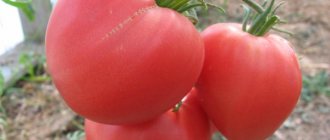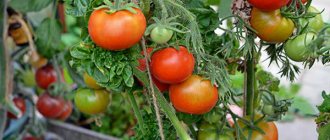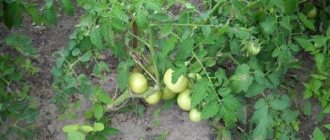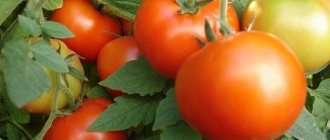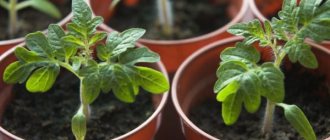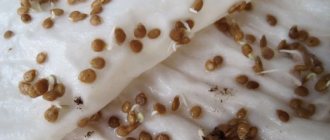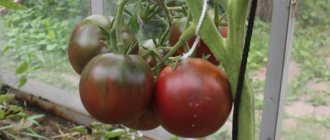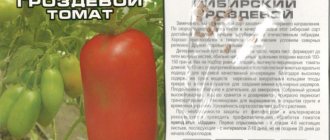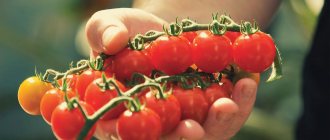Ryaba hen is a determinate, ultra-early tomato. The plant of the variety Hen Ryaba covers the fruits with its leaves, like a hen covers its chicks. This is a definite advantage of this variety, since in hot summers the tomatoes do not have to be protected from the sun. The plants themselves are creeping, low-growing - only 30 - 50 cm tall. No pinning required. The fruits are round-elongated, dense, pinkish-red, with yellow stripes, weighing 100 - 150 grams. The productivity is very high. The lightness and transportability of tomatoes is good. This variety is excellent for both fresh consumption and canning.
The tomato has proven itself well when grown without seedlings. Seeds retain good germination for 5-6 years.
To purchase a product in our online store, select the product you like and add it to your cart. Next, go to the cart and click on “Place an order” or “Quick order”.
When placing a quick order, write your full name, phone number and e-mail. The manager will call you back and clarify the terms of the order. Based on the results of the conversation, you will receive confirmation of product registration by email or via SMS. Now all you have to do is wait for delivery and enjoy your new purchase.
Placing an order in standard mode looks like this: Fill out the form completely in successive stages: address, delivery method, payment method, personal information. We advise you to write information in the comments to your order that will help the courier find you. Click the "Place an order" button.
Pay for purchases in a convenient way. There are 3 payment options available in the online store:
- Cash upon pickup or delivery by courier. A specialist will contact you on the day of delivery to confirm the time and prepare change for any banknote in advance. You sign shipping documents, deposit funds, receive the goods and a receipt.
- Cashless payment for pickup or ordering in the online store: Visa and MasterCard cards. To pay for your purchase, the system will redirect you to the ASSIST system server. Here you need to enter the card number, expiration date and name of the holder.
- Electronic systems for online ordering: PayPal, WebMoney and Yandex.Money. To make a purchase, the system will redirect you to the payment service page. Here you need to fill out the form according to the instructions.
Save time on receiving your order. There are 4 delivery options available in the online store:
- Courier delivery works from 9.00 to 19.00. When the goods arrive at the warehouse, the courier service will contact you to clarify the details. The specialist will offer to choose a convenient delivery time and specify the address. Inspect the packaging for integrity and compliance with the specified contents.
- Pickup from the store. A list of outlets to select will appear in your shopping cart. You will be notified when your order arrives at the warehouse. To receive your order, contact an employee in the checkout area and give the number.
- Postamate. When the order arrives at the outlet, a unique code will be sent to your phone or e-mail. The order must be paid at the parcel terminal. Shelf life: 3 days.
- Postal delivery via Russian Post. When the order arrives at the department, a parcel notification will be sent to your address. Before paying, you can evaluate the condition of the box: weight, integrity. You can open the box yourself only after paying for the order. One order can contain no more than 10 items and its cost should not exceed 100,000 rubles.
source
Interesting fact about the fairy tale “Ryaba Hen”
For example, a long time ago I heard a specialist comment on the radio about the true meaning of the plot of the fairy tale “Kolobok”. In essence, this is a description of the phases of the waning Moon (i.e. the same round shape). There are early versions of the fairy tale, where every animal Kolobok encountered would bite off a piece of him (defective month), until the fox ate him completely (new moon). It was understood that each animal is the personification of various constellations in the area of which the Moon found itself at a certain point in the cycle.
This version may not be the most correct, but it deserves attention.
what kind of nonsense is that? Some ghoul sits and looks for the hidden meaning in fairy tales, shovels ancient legends, symbols and begins to attach them to meaningless words.
it’s like in a joke: they are interviewing a writer: - but in your novel “XXX” the action takes place in the fall, and the hero has a yellow cloak, apparently here you used the language of symbols, this probably meant approaching depression, which is evident from some of his phrases. and so on blah blah blah blah blah blah for 10 minutes. writer: no, I just decided that it would be autumn and not summer/spring/winter and I like the color yellow
and here is a slightly different interpretation of this tale: Chicken Ryaba: a traditionalist analysis of a Russian folk tale
1. Once upon a time there lived a grandfather and a woman, 2. They had a pockmarked chicken. 3. The hen laid an egg: 4. Motley?, vostr?, kostyan?, wise?, - 5. She planted the egg in an aspen hollow, 6. In a hole under a bench. 7. The mouse ran, returned with its tail, 8. Broke a testicle. 9. Grandfather began to cry about this testicle, 10. Grandmother began to sob, and burst into laughter, 11. Chickens flew, gates creaked, 12. The rubbish under the threshold was covered up, 13. The doors began to shake, the roof crumbled, 14. The top of the hut began to shake. 15. And the pockmarked hen tells them: 16. “Grandfather don’t cry, grandma don’t cry, 17. Chickens don’t fly, 18. Don’t creak the gate, litter is under the threshold 19. Don’t light a cigarette, 20. Tyn don’t fall apart, 21. Top on the hut don’t stagger - 22. I’ll lay another egg for you: 23. Motley?, bright?, kostyan?, wise?, 24. The egg is not simple - golden.
1. Kut - a corner in a hut, a counter, a stall in which chickens were kept in winter. 2. Verei - pillars on which gates were hung. 3. They stuck out - they stuck out, arched, loosened up. 4. Tyn - a solid wooden fence, palisade.
The fairy tale “Ryaba Hen” is an interesting text in which you can see several myths related to cosmogony, eschatology and the traditionalist cyclicality of eras.
Lines 2-3, 5-8. Ryaba the hen lays an egg. The mouse touches it with its tail and breaks it. In the ancient Greek Pelasgian myth about the creation of the world, Eurynome - the goddess of all things - rose from Chaos and conceived from the north wind Boreas, who appeared in the form of the serpent Ophion. Eurynome, turning into a duck, laid the World Egg on the waves. At her request, the serpent Ophion wrapped himself around the egg seven times and incubated it until it broke and “everything that exists in the world” appeared from it.
The image of a bird that lays a World Egg (in particular on water) is quite common in world mythology. Let's give just a few examples. The Kalevala describes how a duck, “the daughter of the air,” conceived from the eastern wind and laid several eggs on the knee of the water mother Ilmatar. The eggs eventually broke and from their fragments the world was born2. Similar cosmogonic symbolism can be found in Komi mythology.
In Hinduism, the divine bird lays on the primordial waters the Cosmic egg from which Brahma arose3, and in ancient Indian mythology the golden embryo - Hiranyagarbha - is the original form of Prajapati, the creator of the Universe4.
The Old Testament also contains echoes of this archaic myth: “The Spirit of God hovered over the waters” (Gen. 1:2). This correspondence is also indicated in the “Explanatory Bible” edited by professor of theology Lopukhin A.P.: “The very action of the Holy Spirit on chaos is likened here to the action of a bird sitting in a nest on eggs and warming them with its warmth to awaken life in them”5 .
The connection between the bird and the world egg can also be traced in ancient Egyptian mythology: in the Hermopolitan cosmogony, the white goose “Great Gogotun,” the embodiment of the earth god Seb, lays an egg from which the sun god Ra6 is born.
In the fairy tale “Ryaba Hen,” an egg is broken by a mouse. The mouse is an extremely symbolic image in mythology. In the Mediterranean countries - Egypt, Palestine, Greece - it was believed that the mouse was born from the earth. Indeed, many researchers point to the chthonic symbolism of the mouse, which is also confirmed in the language: rat (Russian) - hruse (Old English "earth") - tarpaulin (Russian dialect "top layer of the earth"), and also: geli- (Indo-European proto-language “mouse”) - qela (Lydian “earth”). Another chthonic animal, the snake, is equally symbolic. In this sense, the mouse and the snake are equated (Compare: shchur (Russian dialect “rat”) - worm (Russian), and also: sorex (Latin “mouse”) - sauroz (Greek “lizard > “snake”) 7.
Thus, having compared the beginning of the analyzed tale and the Pelasgian myth of creation, we saw the identity of the logical constructions:
Eurynome in the form of a dove -> World Egg egg
Characteristics of Klusha tomato
The Klusha tomato is extremely popular among modern gardeners. Bred by Russian breeders in the early 2000s, over the course of several years these tomatoes became favorites among both professional farmers and amateur summer residents. Numerous positive reviews, videos and photos on the Internet indicate that this variety has a huge number of advantages and benefits.
Characteristics of Klusha tomato
How did the Klusha tomato variety get its name? Despite the fact that this plant cannot boast of a large bush size, many delicious fruits grow on them. This is where the name of this variety of vegetable comes from, by analogy with a laying hen. Literally a few tomato bushes give a yield of up to two and a half kilograms. And with proper care, the number of fruits grown per square meter can average twelve kilograms.
Description of the variety
Klush tomatoes are early ripening varieties. The best time to plant sprouts is March. The first harvest can be harvested within three months after planting the seeds in the ground. The plant is a small neat bush, up to sixty centimeters in height, with all the fruits securely covered with abundant foliage. Thanks to its compact size, up to seven tomato bushes can be placed on one meter of land, which will result in a solid yield.
According to reviews and photos of gardeners who prefer this variety, Klusha tomatoes are red or pink. The shape of the fruits is round and not very large. Due to the fact that the fruits are not large in shape, this is the variety of tomato that housewives prefer when preparing home canned food.
Another variety of the variety is the Superklusha tomato - tasty, juicy fruits with pink flesh. This type of tomato has the same advantages as its counterpart. Pink tomatoes will delight any housewife with their taste, and their unpretentiousness will appeal to every gardener. As a rule, the weight of one fruit reaches up to two hundred and fifty grams, so this variety, like no other, is suitable for preparing a summer aromatic salad.
Benefits of tomato
The indisputable advantage of these tomatoes is that they can be grown not only in the garden, in the garden or at the dacha, but also in special containers on the balcony, loggia, or greenhouse, and they will also bear fruit well. Tomatoes grown in a greenhouse will bear fruit until winter, so you will have fresh vegetables on your table until the new year.
Most often, in the description of the Klusha tomato variety, vegetable growers and farmers note some undeniable advantages.
- Firstly, such a plant is characterized by unpretentiousness in growing methods and high yield.
- Secondly, the Klusha variety can grow under any climatic conditions characteristic of our country, even such as Siberian weather changes.
- Thirdly, the fruits have excellent resistance to various diseases, from which, as a rule, all vegetable crops suffer.
- Fourthly, they are not whimsical and do not require particularly close care: they do not require gartering or removal of shoots. This type of tomato does not need staking. However, it is better not to neglect this process if the harvest is especially abundant.
- Fifthly, they are easily transported and do not deteriorate during storage for a long time.
A positive characteristic of the early-ripening Klush tomato is that this tomato has a very pleasant and memorable taste. And in general, farmers who grow these plants are unanimous in their opinion - the variety in question simply has no drawbacks.
Tomato Golden: reviews, variety description, photo
Description of the variety: An indeterminate pepper-shaped hybrid, intended mainly for growing in protected soil (under a film cover). The bush is powerful, tall, and needs staking and pinching. Relatively resistant to diseases.
The fruits are elongated, up to 10 cm long, resembling a pepper in shape, dark red in color when fully ripe, highly transportable, and well stored. On the bush, the fruits are collected in clusters, the ripening of the fruits on the cluster is uniform, so these tomatoes can be collected in clusters.
The fruit is three-chambered, the seed cavities are small, and the flesh is sweet. Great for salads, canning and processing.
Included in the State Register for the 5th light zone for cultivation in film greenhouses in spring-summer rotation. A mid-early salad hybrid, used for whole-fruit canning. The plant is indeterminate. The inflorescence is simple. The fruit is cylindrical, hard, red, 3-chambered. Fruit weight 180 g.
International name: Pozzano F1
Originator: ENZA ZADEN BEHEER BV, Netherlands
Plant height: 2-3 meters
Fruit weight: 130-180 g
Productivity: 9.5-25.4 kg/sq.m. meter
A very beautiful bush, a lot of fruits, not painful, although out of the total number of tomato plants, one on the third cluster suffered from blossom end rot. In fact, all these characteristics can be given to the rest of the hybrids. I was prejudiced against hybrids, but now, having grown hybrids, I have changed my mind.
It is very pleasant to watch how they grow, set fruit (many are already bearing their sixth cluster), and practically do not get sick with minimal care. I didn’t like the Chukhloma hybrid. Somewhat flimsy. In the heat, the leaves withered, died every day, and were gone overnight in the morning. The rains passed, it became cooler - I got stronger, but - there are not enough tomatoes on the bush, almost all of them got sick with blossom end rot, so in general I came to the conclusion - the hybrid is not mine. (Tatyna, Nikolaev, Ukraine)
I chose them based on their characteristics due to their resistance to blossom end rot and especially for greenhouse cultivation. But there was confusion and several indeterminate hybrids accidentally ended up in the open ground, including Pozzano. Having noticed during the growing process that these were indets, I had to change their stakes and grow them into two or three shoots.
It lends itself very easily to this forming and carries the load remarkably well. The fruits did not shrink at all. The bushes did not suffer from any disease until the frost and kept bearing fruit all the time. Was not noticed in the shedding of flowers and ovaries. I really want to try it in the greenhouse. Almost all of it went into drying. (Galina, Western Ukraine)
For the third year now, the indeterminate tomato Pozzano (Olexandr Mamchur, Ukraine) has been one of my favorites.
In this article we will talk about the main characteristics and features of cultivating the “Golden” tomato variety.
Yellow-fruited tomatoes are always popular among summer residents. The fruits of these varieties are devoid of lycopene, but contain large amounts of carotene, natural sugars and biologically active substances that are beneficial to human health.
Yellow tomatoes have a delicate, pleasant taste that fits harmoniously into summer vegetable salads and look great in homemade marinades.
Finally, they can be consumed by people suffering from intolerance to “red” plant pigments.
Yellow tomatoes contain large amounts of carotene, natural sugars and biologically active substances
| Parameter | Characteristic |
| Culture | Tomato (Solanum lycopersicum L. var. lycopersicum) |
| Ripening period | Early |
| Period from germination to fruiting | 92-100 days |
| Marketable yield | On average 10 kg/m2 |
| Fruit weight | 100-150 g |
| Form | Flat-round, ribbed |
| Coloring of ripe fruits | Orange |
| Skin | Leaky |
| Pulp | Juicy, sweet, aromatic |
| Number of slots | 4 or more |
| Taste qualities | Good |
| Transportability and keeping quality | Average |
| Purpose | Salad, suitable for processing into juice and sauces |
| Plant type | Determinate, 70-80 cm high |
| Leaves | Large, dark green |
| Inflorescence | Intermediate type |
| Features of cultivation | Plants need pinching and tying to supports |
| Sustainability | The variety is cold-resistant and is practically not affected by late blight. |
| Recommended growing regions | All regions (in open ground and under film covers) |
| Year of registration in the Federal State Budgetary Institution "State Varietation Commission" | 2008 |
| Originator | LLC Agro (Domodedovo) |
The variety was bred by specialists from Agro, one of the most respected breeding enterprises in the country. The “Golden” tomato was registered in the State Register in 2008 and is intended for cultivation throughout Russia in open ground and in summer unheated shelters.
Tomatoes of the “Golden” variety have a flat-round shape and small size
Plants are determinate, low-growing. Bushes 70-80 cm high need pinching and tying to supports. Early ripening tomatoes (92-100 days from full germination), flat-round shape, leveled, weighing 100-150 g.
Fruit set is uniform and high. The color of tomatoes ranges from lemon yellow to light orange. The pulp is juicy, very good taste, with a pronounced “tomato” aroma.
Tomatoes of this variety are recommended for canning (sauces, juice)
The variety is cold-resistant and is practically not affected by late blight due to the friendly and early yield of fruits. The yield is stable, about 10 kg per square meter. Seeds collected from “your” plants can be used for sowing.
The positive qualities of the “Golden” tomato are fully confirmed by experienced gardeners. It can be recommended to novice summer residents as a reliable and virtually problem-free source of healthy and tasty fruits.
Different packages of seeds of the “Golden” tomato variety
Nadezhda, 32 years old, Podolsk
A very nice variety. No problems growing.
True, for the first three weeks the planted seedlings had to be kept in a film “tunnel”, since the beginning of summer was cool, but then only gartering and the usual treatments for diseases.
The bushes formed into 3 stems. There were a lot of tomatoes, all beautiful, even, although small. I liked the taste and the juiciness too. I wanted to make the sauce, but I didn’t have time: everything was eaten fresh.
Igor, 49 years old, Ufa
I grew the variety a couple of years ago under a film cover. Quite a decent variety. I was pleased with the almost 100% germination of the seeds. The fruits set together, the clusters were dense. The tomatoes are smooth, beautiful orange in color. The taste is pleasant, sweetish. I liked that the pulp was juicy and aromatic. There were no difficulties with growing. I'll have to buy seeds again and plant them next year.
Valentina, 53 years old, Lipetsk region.
I am pleased with the early and friendly yield of the harvest. More than once I wanted to try these tomatoes in marinades. The size and shape are good, although they say they are too watery for that.
Features of cultivation
Growing a plant will not give you any trouble
Since Klush tomatoes are very unpretentious, they do not require special care. Therefore, you should not have any problems growing them. The main thing is to properly cultivate the soil and prepare the seeds for sowing. And rest assured, super productivity is guaranteed!
In order to plant sprouts correctly, you need to follow simple rules.
- According to the characteristics and description of Klush tomatoes, in order to plant seeds it is better to take garden soil. You should not buy special soil, as there may be problems with plant adaptation.
- Treat the seeds with a weak one percent solution of manganese (at a ratio of 2:1). You can also soak the soil in which the sprouts will grow.
- To grow seedlings, it is better to take small containers. When planting seeds, remember that they should not be immersed in the soil deeper than one centimeter.
- After the seedlings sprout, they must be planted in separate containers. Please note that they should be replanted along with the soil in which they grew. Otherwise, the roots that have not yet strengthened may be damaged.
- Since tomato bushes are not very large in height, you should not plant them deeper into the ground than one centimeter.
- During planting, the seeds should be covered with peat and not watered.
- At the end of picking, it is recommended to cover the seedlings with film and leave them in a dark place for several days until they begin to sprout. Transplantation into the ground is carried out after the plants have grown to a height of at least twenty centimeters.
How to care for plants?
Growing them does not require any complex manipulations. The rules for caring for tomatoes are simple; anyone, even a novice gardener, can handle them.
- Remember that necessary and proper care for sprouts requires plenty of moisture. The fruits should be watered once a day in the late evening, preferably not with cold water.
- Don't forget about weeds. These tomatoes do not tolerate such a neighborhood, so carefully monitor the cleanliness of your garden bed.
- Tomatoes also like it when the soil in which they grow is periodically loosened. In addition, use standard mineral fertilizers to feed the plant at least twice a season.
- In order to give the fruit a sweetish taste, it is necessary to tear off the lower leaves of the plant, then the sun's rays will directly hit the tomato and speed up the ripening process.
Reviews about Klusha tomatoes are only positive. They indicate that growing this variety does not cause discomfort. Most gardeners speak positively about this type of tomato. People are attracted by its ease of care, convenient and affordable method of cultivation, and resistance to various types of diseases. An undoubted advantage for vegetable growers is the amount of harvest obtained.
Vegetable garden and more
01/30/2019 admin Comments No comments
Irkutsk resident Zinaida Lyubimova continues to share her experience on the pages of our newspaper
Today she will talk about new varieties of tomatoes - those that she personally tried this year. As Zinaida Nikolaevna says, in the city club “Gardener and Gardener”, in which she participates, her friends call her “tomato girl”. Just because every year she grows and tests a large number of new tomatoes. This season she grew 28 new and 15 old, proven varieties. Some of the new varieties were purchased in the store, others were donated (exchanged) by teammates and acquaintances. What is important is that despite the capricious weather this summer (May and June were cold and rainy, and July and August, on the contrary, hot and dry), she was satisfied with the resulting tomato harvest. And therefore, there is something to learn from her.
Before starting to describe the new varieties, I will note: the most popular and beloved among Irkutsk residents are the large-fruited greenhouse bogatyr tomatoes. Their fruits contain a large proportion of pulp, but there are very few seed chambers and seeds (not many). That's why they are more aromatic and sweeter than their regular counterparts. Let's talk about them.
Great new products
“I have a thick notebook in which I describe all the varieties in detail and rate the bushes. So, all five bushes of the Nadezhda that I grew received an “A” each! The height of the bushes to the ceiling is two meters or more. The fruits are round like a ball, even, smooth, beautiful, red in color. In the lower clusters of tomatoes there were five ripened tomatoes, weighing 150-200 g each - in the upper parts, as often happens, there are smaller ones. Brushes go through two sheets. Large-fruited varieties should be grown in one stem. The variety is mid-season.
Also this year I purchased seeds of the Princess Sofia . I noticed this beautiful tomato at the exhibition of the Thomson city club at the Sibexpocenter: among all the tomatoes, a giant fruit stood out, weighing 980 g, and I could not pass by. Unfortunately, neither I nor the other members of our club were able to grow such a huge tomato. The fact is that usually for exhibition, in order to get a large fruit, one fruit is left in the lower cluster, and the plant is well fed. As a result, it gives all its juices and strength to this fruit. But still, I liked the Princess Sofia variety for its early fruitfulness and productivity. The red, flat-rounded fruits began to plump and turn red, one of the first among large-fruited varieties. The lower clusters ripened 3-4 fruits, weighing about 200 g. And although the height of the bushes was small, 1.2-1.4 m, there were a lot of clusters, the yield was excellent. The variety is ideal for low film shelters (greenhouses).
Cardinal variety was given to me and given the most flattering description. Indeed, the variety is very productive, and I was very pleased with it. The fruits have an interesting shape - elongated and thick, with a small spout. The weight of these red tomatoes is 200-300 g. The lower clusters bear 4-5 or even 6 fruits. Fruiting is abundant and long lasting.
They also gave me an excellent amateur variety called Lithuanian . It can be grown both in a greenhouse and in a greenhouse, the height of the variety is 14 m. I grew the plants in one trunk, in the first cluster the fruits of 5 pieces weighed 150-200 g, in the upper ones they were smaller. The bright red, flat-round fruits have juicy, fleshy, and very tasty flesh. The variety is recommended for fresh consumption and for making tomato juice.
From
“I received varieties for testing and in the well-known one there are only four varieties. Most of all I liked the tall variety Rumyany : on each cluster there are five even, smooth, shiny fruits of a perfectly round shape; they were worthy of any exhibition. The fruits were initially light green, then deep red, weighing 150-200 g (up to 300 g), with sweet, juicy pulp. I grew it in one and two trunks, there were a lot of brushes. The variety is mid-season.
The second variety from is the large-fruited, low-growing variety Tolstushka . This variety received only a C from me: the fruits are three times smaller than declared, and there are very few of them. This is an indeterminate (high) variety. I note that I also bought the same variety, Tolstushka, in another store. I really liked him. This is a new variety of Siberian selection, with large, fleshy fruits of raspberry-pink color, heart-shaped, weighing up to 500 g. The variety is plastic, quite undemanding to growing conditions, and sets fruit well in Siberian conditions. Salads and tomato products made from the sugary, sweet fruits of this variety have excellent taste and aroma.
The third grade from - Lamp . In general, I like to grow tomatoes of different shapes, colors and sizes. Lampa’s fruits are pear-shaped, weighing 100-150 g, bright orange in color, beautiful when preserved and in salads. Late ripening variety. The pulp is dense, sweet, with a high content of carotene.
I can’t help but tell you about the very productive, unusual variety Candle in the Wind . Even its name is unusual, and the fruits look very original. The height of the bushes is 2-2.5 m. The shape of the fruits is more reminiscent of peppers - long thick icicles with a sharp nose. The length of the fruit is 12-15 cm, thickness 4-5 cm. The tomatoes are red, weighing 100-150 g, dense, good taste, intended for long-term storage. The variety is late-ripening: back in November I prepare salads from them. This Candle in the Wind won me over, because I love tomatoes of different ripening periods (when all varieties ripen at the same time, it is very difficult to process them). In addition, this variety stands out among its fellows with large clusters (4-6 pieces each).
Multi-colored fruits
— An original mid-early variety with large fruits the color of milk chocolate — Chocolate Miracle . In open ground it reaches a height of up to 100 cm, in protected ground it reaches 1.5–2 m. Large, flat-rounded fruits weighing 250–400 g acquire an interesting color when ripe. Dense and sugary, they have a magnificent sweet taste inherent in all dark-colored varieties. The variety is characterized by high yield under any growing conditions. In addition, I grew black varieties: Bedouin , Black Prince , Chernomor , De Barao black .
It should be noted that I grow 1-2 bushes of small-fruited tomatoes of different colors every year. This year - Pink Raisins (pink color), Grapes (oval orange fruits) and Yellow Necklace (yellow color). Plants were grown in two trunks. They are very tall, but I don’t pinch them, I just bend the branches away from the glass when they reach the ceiling (roof). There are a lot of brushes, so these varieties are very productive.
The Yellow Necklace has the earliest and sweetest fruits. The clusters are very large - it is even difficult to count the number of fruits in the cluster. Round tomatoes weighing 10-30 g are very popular with children; they graze near these bushes, wait for the fruits to color, and eat them from the bush.
Grapes are cylindrical fruits, weighing 20-50 g, hard, dense, mid-ripening. I especially love this variety for pickling: the fruits can easily be placed in the smallest voids between cucumbers or large tomatoes.
Pink raisins are an excellent productive variety of Ukrainian selection. A powerful bush 1.5-2 m high forms large branched clusters with 50-60 pink plum-shaped fruits weighing 30-50 g. They are very tasty fresh and suitable for all types of canning. This variety resembles the variety Cio-Cio-san , only it is taller.
Open ground tomatoes
Outdoor tomatoes require less care than greenhouse tomatoes. Early varieties ripen well, and tomatoes, caressed by the sun, produce deliciously tasty and healthy fruits. Previously, I grew a large-fruited variety with red fruits - Grandma's Secret . And this season - Grandma's Kiss . The height of this large-fruited and mid-early variety is 70-110 cm. The fruits are juicy, lemon-yellow, sweet, weighing 150-200 g, individual fruits weigh up to 500-600 g (though I didn’t have any of these) and are used for preparing delicious salads. Smaller fruits, from the last clusters, are used in pickling. They compare favorably with red ones in terms of taste. Fruiting is extended. The first fruits ripened in August, and they are still there in November.
the Pink Honey variety three times . At first I bought the seeds in the store, but then I didn’t like the variety - the fruits were small and the yield was poor. Then I took seeds from friends twice. And now this variety pleased me - it was the best among all the street varieties. I gave all three bushes an A plus. The height of the bushes is 80, 100, 120 cm. The productivity is excellent! The tomatoes were the largest of the street ones - 600 g (I had the greenhouse variety Fidelio this year - 800 g). Some of the fruits ripened in mid-August. The shape of the scarlet fruits is slightly heart-shaped, the taste is excellent!
In addition to the varieties described that are new to me, I have many excellent varieties for the greenhouse, hotbed and outdoors. Therefore, if you have any questions, please call 38-14-91.
Hybrid varieties of grape tomatoes for the greenhouse
The preparation of the festive table is ahead, the thought of beautiful red and yellow tomatoes comes first. Indeed, this beloved crop by many rightfully takes its leading place not only on the table, but also on the summer cottage.
The fruit, rich in vitamins, freshly picked from a tomato plant, is useful. At the end of the season, the tomatoes are sent for processing. They cannot be dried or frozen at home.
Tomatoes collected with trusses stay fresh much longer because, by inertia, they take food from green branches. Bunch varieties are distinguished by absolutely even fruits and a universal purpose.
There are many raceme tomatoes, most often they belong to hybrid selection. The most famous of them are a series of cherry tomatoes. Let's expand our understanding of the group of grape tomatoes with varieties and hybrids with large fruits that can be grown in your greenhouse, having a plot in any region.
From experience: it’s cheaper to grow than to buy in the supermarket. The profitability of large-fruited tomatoes has long been appreciated by greenhouse farmers.
The description of the main characteristics in the article will help you make a choice in favor of large hybrid tomatoes in bunches.
Most raceme tomatoes are hybrids bred to grow in protected soil. A well-built heated greenhouse allows you to harvest twice a season.
The moment of choosing varieties and hybrids is important. It is tempting to purchase many different planting materials based on beautiful, bright photos of tomatoes. Many plant species under one roof leads to many cross-diseases. Breeders recommend placing several different varieties of tomatoes in a greenhouse according to the scheme, alternating 1-2 familiar and 1-2 new tomatoes.
Advantages of greenhouse cultivation.
The choice of tomato varieties and hybrids for greenhouse conditions is much greater than for open garden beds. Among them there are representatives of determinant, semi-determinate, indeterminate - all bear fruit well under film or glass cover.
general information
There is a huge selection of tomato seeds on the market for amateur gardeners and farmers: as they say: “Your eyes run wild.” So, what should we choose? How to find something worthwhile, because the harvest depends on the right variety, and it “feeds the year.”
In this abundance, among the low-growing representatives of the determinate type, the “Klusha” tomato stands out; reviews and photos of its yield are simply pleasing and inspiring.
This variety wins the hearts and gardens of summer residents with its friendly harvest, bright and even fruits.
Tomato “Klusha”: characteristics and description of the variety
- Refers to low-growing types of tomatoes for open ground, medium-early ripening;
- The bush is standard, up to 60 cm high, quite stable, does not require support;
- Does not require pinching;
- The plant is compact, 1 sq. meter you can plant up to eight pieces;
- Abundant harvest: 2–2.4 kg per bush;
- Friendly maturation;
- Handles transportation;
- The fruits are round, red, weighing from 90–120 g, but can also weigh 150 g;
- Universal purpose: suitable for processing and fresh consumption;
- Taste – regular, tomato, sweet and sour;
- It can be grown in open ground, greenhouses, with a closed root system in flowerpots and boxes.
Creeping tomatoes: features, advantages and disadvantages
Gardeners who already grow varieties with limited growth have appreciated the strengths of these plants.
Creeping tomatoes do not need to be tied up, pinched or protected from strong winds. Even when grown in open ground, they bear tasty fruits on average 90-100 days after seed germination. Consistently high yields plus a long fruiting period complement the list of advantages.
The list of disadvantages includes only two points: contact of fruits with the ground and a modest selection of varieties.
Advantages and disadvantages of the variety
Let's see, are these tomatoes really that good?
According to the rules, the lower leaves must be torn off, and the stepsons are pinched, leaving a stump of 1.5 cm, since they will be of no use. But the upper stepsons are left, since the variety is determinate, that is, not tall, and stops growing on its own, ending the crown with a flower brush.
Stepchildren above the fifth leaf are left, turning them into additional stems. As soon as they form ovaries, excess stepsons are removed from these stems.
For what? So that the harvest has time to ripen together, the fruits do not become smaller, and the ovaries do not fall off. By pinching the shoots, you save the plant’s strength, which it will gladly give to the fruits. You should not be greedy, because you are growing for yourself, and a quick harvest is more useful than from an exhausted plant that has to be fed so that it has time to produce a couple more fruits.
Do not forget that the Klusha tomato has a medium early ripening period. These varieties are distinguished by the fact that they yield their harvest in 100–110 days, and it is very important not to make mistakes with the timing of sowing the seeds.
What do we get? In the middle zone in mid-June, the average temperature is 15–20 degrees, which is comfortable for the growth of heat-loving plants like tomatoes, and they should be planted at this time. From the 15th we subtract 60, it turns out April 15, we also subtract 5 days for germination, it turns out that the optimal sowing for Klusha tomatoes is April 10.
Everyone will find their own mistakes, that you should not germinate seeds of different varieties at once, guided only by the lunar calendar or a free weekend.
After all, planting time is very important! The success of the harvest depends on it. If you sow tomatoes earlier, as many try to do, it turns out that it is not young, fresh seedlings that are planted in the ground, ready to “give birth” to large, healthy offspring, but an “old woman” whose growing season is already running out.
Let's collect the advantages:
- Early ripening and productive variety;
- The bush is low-growing and compact;
- Easy to care for;
- Does not succumb to diseases;
- Universal purpose;
- Suitable for any region and climate;
- The fruits are of high commercial quality and can easily be transported;
- Can grow in containers at home or on the balcony.
Are there any disadvantages to the Klusha tomato?
Some gardeners include the following qualities as the disadvantages of this variety:
- Short-term storage;
- Small fruits.
But, let me! Early ripening varieties have a harvest and should not lie around for a long time. The good thing about them is that they ripen by mid-August and are ready for processing, which allows them to avoid diseases such as late blight.
Dissatisfaction with small fruits is also inadequate, since the tomato is not a salad tomato, but a universal one. Yes, it does not have sugar content, but this is rather a “plus”, and therefore it can be consumed by people with high blood sugar levels and who are watching their figure.
Here is the conclusion - this variety has no disadvantages!
Characteristics and description of the Spanish Giant tomato variety, its yield
Usually gardeners boast about their tomatoes and the mass of fruit. If you manage to grow a Spanish giant tomato and get even a few tasty fruits from it, then this is a great success. One tomato is enough to feed the whole family with salad.
Many farmers distinguish tomato varieties that produce fruits weighing five hundred grams or more. These include the mid-late Spanish giant. In addition to the large mass of the tomato, it is given the following characteristics:
Warmth is important for this variety; it does not tolerate temperature changes, so it is better to grow it in greenhouses.
A heat-loving tomato plant, prefers areas with a hot climate. There are all conditions for rapid development and high yields. The rays of the sun, warm wind, and soft rain help the fruits to ripen quickly. In temperate climates, such varieties, giants, are best planted in seedlings.
Preparing seedlings
If in the southern regions you can sow a vegetable plant at the end of February, then in a temperate climate - in mid-March. You can determine the timing yourself if you count 55-65 days from the end of frost. Sowing of Spanish Giant tomatoes for the greenhouse begins two weeks earlier.
To create tomato seedlings, the following conditions are necessary:
Preparation for sowing tomatoes plays an important role. It includes disinfection of seeds and soil. The seed material goes through the stage of treatment with a solution of potassium permanganate for twenty minutes, baking soda (0.5 grams per half glass of water). It helps to keep the seeds healthy by placing them in liquid Fitosporin for two hours.
Ten days after the procedures, they begin to plant the seeds. They are sealed to a depth of one centimeter. The distance between seedlings should not be small, otherwise the seedlings will not have enough nutrients.
Boxes with seedlings are placed in a warm place, covered with film, and often moistened. Usually after three to four days the plants begin to hatch. Sprouts require care in the form of:
If the plantings are crowded, as soon as two or three true leaves appear, seedlings begin to pick.
The signal for transferring tomatoes to the greenhouse is the laying of the first flower clusters. Ten days later, the seedlings are planted in closed ground.
Planting in a greenhouse
Prepared greenhouses are supplied with healthy soil, which must be disinfected. The earth is poured in a layer of seventeen centimeters on layers of manure. To prevent the appearance of pathogenic fungi, the manure should be powdered with wood ash or lime fluff. Tomatoes love nutritious soil with high permeability to water and air. The universal composition will be a mixture of chernozem and peat.
Features of growing the “Klusha” variety
As mentioned above, we determine the time for sowing seeds for seedlings, soak them in the “Fitosporin” solution, which accelerates germination and protects seedlings from diseases.
Sowing seeds
For planting, it is safer to use purchased soil: pour it into flat containers 5–7 cm high, pour a warm solution of potassium permanganate into the grooves.
There should be 5 cm between them, and bury the seeds no more than 1 cm, make the distance between the seeds at least 2 cm, and carefully sprinkle with soil. Cover the containers with cling film or glass and place them in a room where the temperature will be constantly 22–25 degrees.
Seedling care
After 3–5 days, when shoots appear, remove the film and lower the daytime temperature to 20 and the night temperature to 16 degrees. Do not let the soil dry out, but do not flood it either.
At this time, the seedlings need to be illuminated: daylight should not be less than 16 hours. Although Klusha tomatoes do not stretch, a violation of the light regime can play a bad role for the future harvest.
Picking
As soon as two true leaves appear, it’s time to dive.
Pour soil into the pots for seedlings, which is prepared in advance: sand, peat and humus are taken in equal quantities, mixed and fertilizing containing phosphorus is added. This element strengthens and develops the weak root system of tomatoes. This is necessary for this variety, since seedlings cannot be deepened when planting due to the fact that “Klusha” is a low-growing bush. Therefore, our task is to develop the root system.
Don’t worry that the plant seems to stop growing, this is because roots are growing. At this time, loosen the soil carefully with tweezers.
When five leaves appear, repeat the fertilizing procedure, but this time with liquid, and for prevention, treat the seedlings with a pest repellent, for example, Confidor.
If the leaves of the seedlings are closed, space them away from each other to allow light access to the stems, protecting the plants from stretching.
Ideal finished seedlings are bright green, stocky, with buds in the first inflorescence.
Transplanting seedlings into the ground
When planting plants in the ground, prepare a hole at least 25 cm deep and pour plenty of water with potassium permanganate heated in the sun.
Then phosphorus-containing fertilizer is poured into it, according to the folk recipe - a scoop of ash from burnt straw or grass, weeds, but not from the barbecue! Onion and garlic peels are added to prevent pests. The holes are made at a distance of 20–30 cm from each other and the same amount between the lines. Plant the tomatoes carefully, trying not to expose the roots, fill the hole with earth and mulch around the plants.
Mulch is best made from pine needles or chopped straw: a cushion 5 cm thick.
This will have a noticeable effect:
- The earth will not dry out;
- At night it will not cool down, and during the day it will not heat up;
- Weeds will not appear;
- There is no need to loosen the soil after watering;
- On such a pillow, the fruits will not deteriorate, even if the plant falls under their weight. This method was called “collective farm” when the bushes were not tied up.
Varieties of creeping tomatoes
All representatives - “Mongolian dwarf”, “Japanese creeping”, “Korean creeping” and “Rock grouse” - are characterized by relatively large fruits compared to ampelous tomatoes and strong branching.
Mongolian dwarf
This super-determinate variety was developed by Novosibirsk scientists. It has not yet been included in the State Register, so seeds can be purchased in online stores and from amateur gardeners.
Main features of “Mongolian Dwarf”:
· Bush height 20-30 cm, width up to 1 m.
· A large number of stepsons that form a green cushion on the ground.
· The fruits are round, red, have a dense pulp of sweet taste with a slight sourness. Weight from 100 to 170 g.
· Even in areas of risky farming, each bush produces 5-8 kg of fruit.
· Long fruiting until the first frost.
· Good resistance to late blight.
During planting, place 2 bushes per 1 m². If you plan to tie the branches to a support, 4 plants are planted in the same area.
